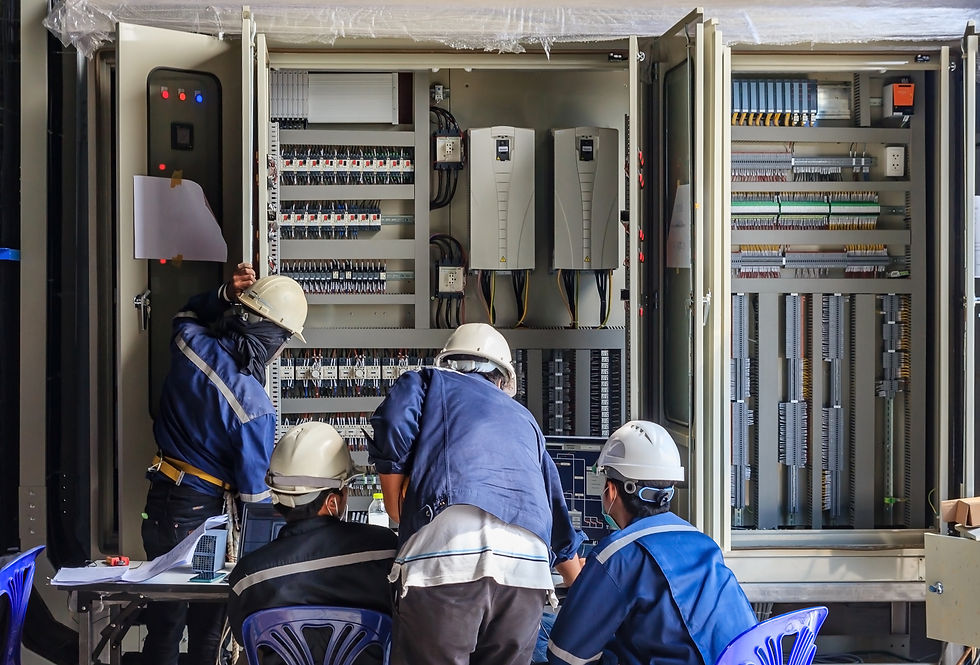What is a Power Factor Controller?
- Embrasul

- Apr 22
- 4 min read
The power factor controller is a device that measures the power factor from electrical signals (voltage and current), calculates the need to insert or remove reactive power through capacitors connected to its output(s), and maintains its index within adjustable limits. There are several types of inputs, outputs, parameters and functionalities. Below, we highlight the main types.
PF control from electrical quantities voltage and current
The equipment is connected to a common point with a group of low voltage loads. The current is measured through intermediate devices such as current transformers and Rogowski coils.

The diagram above shows the input of 3 voltage signals + Neutral, and 3 current signals, which implies three-phase control in a star system. This type of connection is the most common, since it is recommended in unbalanced systems.
There are also single-phase controller models that receive a voltage signal, a current signal and then insert the capacitors. It is important to note that single-phase control implies several caveats and precautions, since imbalance between phases is not uncommon.
When choosing the type of sensor, the number of monitored phases, among other aspects, an energy analysis is always recommended, since this type of study reveals the current dynamics, incidence of harmonics, how many and which capacitors to place, and other important information when sizing the control.
Power factor control from standardized signals
There are controllers that activate the capacitors based on a standardized input signal, such as ABNT CODI, as provided for in NBR 14522. This type of connection is not very common, as it has a series of caveats to be possible.
Good control practices involve correcting the Power Factor as close as possible to a load or group of loads. This type of control allows for an increase in current and circulating reactive power, since this type of connection is closer to the power input at the utility meter and further away from the points that actually cause variation in the power factor.
Types of Power Factor Controllers
Power Factor control can be performed in several ways, the main ones being:
Fixed and Individual: Sizing capacitors connected to the setpoint, without intermediate control.
Automatic in load groups: Using power factor controllers or time control.
Hybrid: Using fixed capacitor banks and automatic control simultaneously.
For each application, a type of control will be more appropriate, assessing the real need for adjustment, and it is at this point that doubts arise in terms of application.
Use of fixed capacitors and banks – no-load transformer and motors
We assume that power factor controllers act to correct reactive excesses, so we apply the correction at points where such variation may exist. Capacitors or fixed capacitor banks are intended to adjust the phase in motors, or even the power factor in a no-load transformer. Note that the capacitors are connected directly to the correction point, since this is a necessity inherent to the “load”.

Use of automatic power factor controllers
It is natural for large energy consumers to have varying operating dynamics, i.e. motors starting and stopping simultaneously, alternately or randomly. Machines operating at full load with high currents, or low loads during less productive periods.
Below, we see a graph of the corrected Power Factor, measured by an energy analyzer. Note that this is an electrical quantity that varies constantly over time.

We are talking about a point higher up in the single-line diagram, and evaluating the Power Factor at a point common to several loads. In this case, we use automatic controllers, since they monitor the variations in the power factor, constantly measuring it, acting when necessary, by inserting/removing capacitors according to the momentary need.

Use of automatic and intelligent power factor controllers
There are periods (night, shutdowns, etc.) where the current and power tend to very small values, towards zero. In this case, we have to be careful. Power factor controllers, in their vast majority, require the electrical quantities voltage and current to be able to calculate the power factor.
But since our current is tending to zero, our controller may run out of current to evaluate. So what do we do?
We are moving towards a hybrid solution! At this point, we are left with our initial fixed and automatic solution at the same time.
There is equipment capable of maintaining fixed banks and having control simultaneously. These same controllers are capable of diagnosing anomalies, malfunctions and even insufficient control.
Which Power Factor controller to use?
For the proper application of a Power Factor Controller, it is extremely important to carry out studies and measurements obtained in an energy analysis.
Knowing the voltage/current levels under full load and at no load, being aware of the presence of harmonics, assessing the financial losses on the electricity bill, through reactive surpluses, or fines, are some of the aspects that we must take care of, as this guarantees effective and, above all, safe control!

EMBRASUL incorporates concepts ranging from the design of the box, where modern materials are used, to the connectors, which offer great operational safety, following the recommendations of international standards.
Through the keyboard/display set, they offer the user system readings in a practical way, as well as an easy parameterization interface, allowing configuration according to the load profile.
Current models offer intelligent control, with alarm systems for cases of insufficiency or burnout, and also maintain measurement and control histories of capacitors, which can be sent to supervisory and energy management systems. It is a controller and meter of electrical quantities at the same time!

Did you like the article? Then download it in PDF format to consult it whenever you want: What is a Power Factor Controller?




Comments